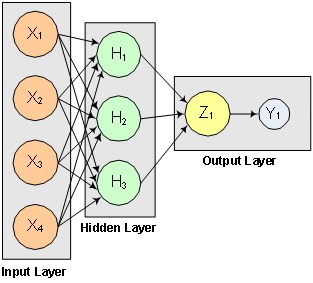Calculates forecasts for trained multilayered feedforward neural network.
Synopsis
#include <imsls.h>
float
*imsls_f_mlff_network_forecast (Imsls_f_NN_Network
*network,
int n_nominal, int n_continuous,
int
nominal[], float
continuous[], ...,
0)
The type double function is imsls_d_mlff_network_forecast.
Required Arguments
Imsls_f_NN_Network *network
(Input)
Pointer to a structure of type Imsls_f_NN_Network containing
the trained feedforward network. See imsls_f_mlff_network.
int n_nominal (Input)
Number of nominal
attributes.
int
n_continuous (Input)
Number of continous attributes.
int nominal[]
(Input)
Array of size n_nominal containing the
nominal input variables.
float
continuous[] (Input)
Array of size n_continuous
containing the continuous input variables.
Return Value
Pointer to an array of size n_outputs containing the forecasts, where n_outputs is the number of output perceptrons in the network. n_outputs = network->n_outputs. This space can be released by using the imsls_free function.
Synopsis with Optional Arguments
#include <imsls.h>
float
*imsls_f_mlff_network_forecast (Imsls_f_NN_Network
*network,
int
n_nominal,
int n_continuous, int
nominal[],
float
continuous[],
IMSLS_RETURN_USER,
float forecasts[],
0)
Optional Arguments
IMSLS_RETURN_USER,
float forecasts[]
(Output)
If specified, the forecasts for the trained network is stored in a
user-supplied array forecasts of size
n_outputs, where
n_outputs is the
number of perceptrons in the network, n_outputs = network->n_outputs.
Description
Function imsls_f_mlff_network_forecast calculates a forecast for a previously trained multilayered feedforward neural network using the same network structure and scaling applied during the training. The structure Imsls_f_NN_Network describes the network structure used to originally train the network. The weights, which are the key output from training, are used as input to this routine. The weights are stored in the Imsls_f_NN_Network structure.
In addition, two one-dimensional arrays are used to describe the values of the nominal and continuous attributes that are to be used as network inputs for calculating the forecast.
Training Data
Neural network training data consists of the following three types of data:
1. nominal input attribute data
2. continuous input attribute data
3. continuous output data
The first data type contains the encoding of any nominal input attributes. If binary encoding is used, this encoding consists of creating columns of zeros and ones for each class value associated with every nominal attribute. If only one attribute is used for input, then the number of columns is equal to the number of classes for that attribute. If more columns appear in the data, then each nominal attribute is associated with several columns, one for each of its classes.
Each column consists of zeros, if that classification is not associated with this case, otherwise, one if that classification is associated. Consider an example with one nominal variable and two classes: male and female (male, male, female, male, female). With binary encoding, the following matrix is sent to the training engine to represent this data:

Continuous input and output data are passed to the training engine using two double precision arrays: continuous and outputs. The number of rows in each of these matrices is n_patterns. The number of columns in continuous and outputs, corresponds to the number of input and output variables, respectively.
Network Configuration
The configuration of the network consists of a description of the number of perceptrons for each layer, the number of hidden layers, the number of inputs and outputs, and a description of the linkages among the perceptrons. This description is passed into this forecast routine through the structure Imsls_f_NN_Network. See imsls_f_mlff_network.
Forecast Calculation
The forecast is calculated from the input attributes, network structure and weights provided in the structure Imsls_f_NN_Network.
Example
This example trains a two-layer network using 90 training patterns from one nominal and one continuous input attribute. The nominal attribute has three classifications which are encoded using binary encoding. This results in three binary network input columns. The continuous input attribute is scaled to fall in the interval [0,1].
The network training targets were generated using the relationship:
Y = 10*X1 + 20*X2 + 30*X3 + 20*X4,
where X1, X2, X3 are the three binary columns, corresponding to the categories 1-3 of the nominal attribute, and X4 is the scaled continuous attribute.
The structure of the network consists of four input nodes ands two layers, with three perceptrons in the hidden layer and one in the output layer. The following figure illustrates this structure:

Figure 13- 13: A 2-layer, Feedforward Network with 4 Inputs and 1 Output
There are a total of 100 outputs. The first 90 outputs use imsls mlff_network_trainer to train the network and the last 10 outputs use imsls_mlff_network_forecast to forcast and compare the actual outputs.
#include <imsls.h>
#include <stdio.h>
int main ()
{
int nominal[300] = {
1, 0, 0, 1, 0, 0, 1, 0, 0, 1, 0, 0, 1, 0, 0, 1, 0, 0, 1, 0,
0, 1, 0, 0, 1, 0, 0, 1, 0, 0, 1, 0, 0, 1, 0, 0, 1, 0, 0, 1,
0, 0, 1, 0, 0, 1, 0, 0, 1, 0, 0, 1, 0, 0, 1, 0, 0, 1, 0, 0,
1, 0, 0, 1, 0, 0, 1, 0, 0, 1, 0, 0, 1, 0, 0, 1, 0, 0, 1, 0,
0, 1, 0, 0, 1, 0, 0, 1, 0, 0, 1, 0, 0, 1, 0, 0, 1, 0, 0, 1,
0, 0, 1, 0, 0, 0, 1, 0, 0, 1, 0, 0, 1, 0, 0, 1, 0, 0, 1, 0,
0, 1, 0, 0, 1, 0, 0, 1, 0, 0, 1, 0, 0, 1, 0, 0, 1, 0, 0, 1,
0, 0, 1, 0, 0, 1, 0, 0, 1, 0, 0, 1, 0, 0, 1, 0, 0, 1, 0, 0,
1, 0, 0, 1, 0, 0, 1, 0, 0, 1, 0, 0, 1, 0, 0, 1, 0, 0, 1, 0,
0, 1, 0, 0, 1, 0, 0, 1, 0, 0, 1, 0, 0, 1, 0, 0, 0, 1, 0, 0,
1, 0, 0, 1, 0, 0, 1, 0, 0, 1, 0, 0, 1, 0, 0, 1, 0, 0, 1, 0,
0, 1, 0, 0, 1, 0, 0, 1, 0, 0, 1, 0, 0, 1, 0, 0, 1, 0, 0, 1,
0, 0, 1, 0, 0, 1, 0, 0, 1, 0, 0, 1, 0, 0, 1, 0, 0, 1, 0, 0,
1, 0, 0, 1, 0, 0, 1, 0, 0, 1, 0, 0, 1, 0, 0, 1, 0, 0, 1, 0,
0, 1, 0, 0, 1, 0, 0, 1, 0, 0, 1, 0, 0, 1, 0, 0, 1, 0, 0, 1
};
4.007054658, 7.10028447, 4.740350984, 5.714553211, 6.205437459,
2.598930065, 8.65089967, 5.705787357, 2.513348184, 2.723795955,
4.1829356, 1.93280416, 0.332941608, 6.745567628, 5.593588463,
7.273544478, 3.162117939, 4.205381208, 0.16414745, 2.883418275,
0.629342241, 1.082223406, 8.180324708, 8.004894314, 7.856215418,
7.797143157, 8.350033996, 3.778254431, 6.964837082, 6.13938006,
0.48610387, 5.686627923, 8.146173848, 5.879852653, 4.587492779,
0.714028533, 7.56324211, 8.406012623, 4.225261454, 6.369220241,
4.432772218, 9.52166984, 7.935791508, 4.557155333, 7.976015058,
4.913538616, 1.473658514, 2.592338905, 1.386872932, 7.046051685,
1.432128376, 1.153580985, 5.6561491, 3.31163251, 4.648324851,
5.042514515, 0.657054195, 7.958308093, 7.557870384, 7.901990083,
5.2363088, 6.95582150, 8.362167045, 4.875903563, 1.729229471,
4.380370223, 8.527875685, 2.489198107, 3.711472959, 4.17692681,
5.844828801, 4.825754155, 5.642267843, 5.339937786, 4.440813223,
1.615143829, 7.542969339, 8.100542684, 0.98625265, 4.744819569,
8.926039258, 8.813441887, 7.749383991, 6.551841576, 8.637046998,
4.560281415, 1.386055087, 0.778869034, 3.883379045, 2.364501589,
9.648737525, 1.21754765, 3.908879368, 4.253313879, 9.31189696,
3.811953836, 5.78471629, 3.414486452, 9.345413015, 1.024053777
};
float output[100] = {
18.01410932, 24.20056894, 19.48070197, 21.42910642, 22.41087492,
15.19786013, 27.30179934, 21.41157471, 15.02669637, 15.44759191,
18.3658712, 13.86560832, 10.66588322, 23.49113526, 21.18717693,
24.54708896, 16.32423588, 18.41076242, 10.3282949, 15.76683655,
11.25868448, 12.16444681, 26.36064942, 26.00978863, 25.71243084,
25.59428631, 26.70006799, 17.55650886, 23.92967416, 22.27876012,
10.97220774, 21.37325585, 26.2923477, 21.75970531, 19.17498556,
21.42805707, 35.12648422, 36.81202525, 28.45052291, 32.73844048,
28.86554444, 39.04333968, 35.87158302, 29.11431067, 35.95203012,
29.82707723, 22.94731703, 25.18467781, 22.77374586, 34.09210337,
22.86425675, 22.30716197, 31.3122982, 26.62326502, 29.2966497,
30.08502903, 21.31410839, 35.91661619, 35.11574077, 35.80398017,
30.4726176, 33.91164302, 36.72433409, 29.75180713, 23.45845894,
38.76074045, 47.05575137, 34.97839621, 37.42294592, 38.35385362,
41.6896576, 39.65150831, 41.28453569, 40.67987557, 38.88162645,
33.23028766, 45.08593868, 46.20108537, 31.9725053, 39.48963914,
47.85207852, 47.62688377, 45.49876798, 43.10368315, 47.274094,
39.1205628, 32.77211017, 31.55773807, 37.76675809, 34.72900318,
49.29747505, 32.4350953, 37.81775874, 38.50662776, 48.62379392,
37.62390767, 41.56943258, 36.8289729, 48.69082603, 32.04810755
};
/* 2D Array Definitions */
#define NOMINAL(i,j) nominal[i*n_nominal+j]
#define NOMINALOBS(i,j) nominalObs[i*n_nominal+j]
Imsls_f_NN_Network *network;
float *stats;
int n_patterns = 100, n_nominal = 3, n_continuous = 1;
int i, j, k, wIdx;
float *forecasts;
/* for forecasting */
int nominalObs[3] = { 0, 0, 0 };
float continuousObs[1] = { 0 };
float x, y;
float *cont;
/* Scale continuous attribute to the interval [0, 1] */
cont = imsls_f_scale_filter (n_patterns, continuous, 1,
IMSLS_SCALE_LIMITS, 0.0, 10.0, 0.0, 1.0, 0);
network = imsls_f_mlff_network_init (4, 1);
imsls_f_mlff_network (network,
IMSLS_CREATE_HIDDEN_LAYER, 3, IMSLS_LINK_ALL, 0);
for (j=network->n_inputs; j < network->n_nodes ; j++)
{
for (k=0; k < network->nodes[j].n_inLinks; k++)
{
wIdx = network->nodes[j].inLinks[k];
/* set specific layer weights */
if (network->nodes[j].layer_id == 1) {
network->links[wIdx].weight = 0.25;
} else if (network->nodes[j].layer_id == 2) {
network->links[wIdx].weight = 0.33;
}
}
}
imsls_random_seed_set (12345);
stats = imsls_f_mlff_network_trainer (network, n_patterns - 10,
n_nominal, n_continuous, nominal, continuous, output,
0);
printf ("Predictions for Observations 90 to 100: \n");
for (i = 90; i < 100; i++)
{
continuousObs[0] = continuous[i];
for (j = 0; j < n_nominal; j++)
{
NOMINALOBS (0, j) = NOMINAL (i, j);
}
forecasts = imsls_f_mlff_network_forecast (network, n_nominal,
n_continuous, nominalObs, continuousObs, 0);
x = output[i];
y = forecasts[0];
printf("observation[%d] %8.4f Prediction %8.4f ", i, x, y);
printf("Residual %8.4f \n", x - y);
}
imsls_f_mlff_network_free (network);
#undef NOMINAL
#undef NOMINALOBS
}
Output
NOTE: Because multiple optima are possible during training, the output of this example may vary by platform.
Predictions for Observations 90 to 100:
observation[90] 49.2975 Prediction 49.1823 Residual 0.1152
observation[91] 32.4351 Prediction 32.4410 Residual -0.0059
observation[92] 37.8178 Prediction 37.7998 Residual 0.0179
observation[93] 38.5066 Prediction 38.4955 Residual 0.0111
observation[94] 48.6238 Prediction 48.5475 Residual 0.0763
observation[95] 37.6239 Prediction 37.6043 Residual 0.0196
observation[96] 41.5694 Prediction 41.5935 Residual -0.0241
observation[97] 36.8290 Prediction 36.8038 Residual 0.0251
observation[98] 48.6908 Prediction 48.6110 Residual 0.0798
observation[99] 32.0481 Prediction 32.0631 Residual -0.0150
